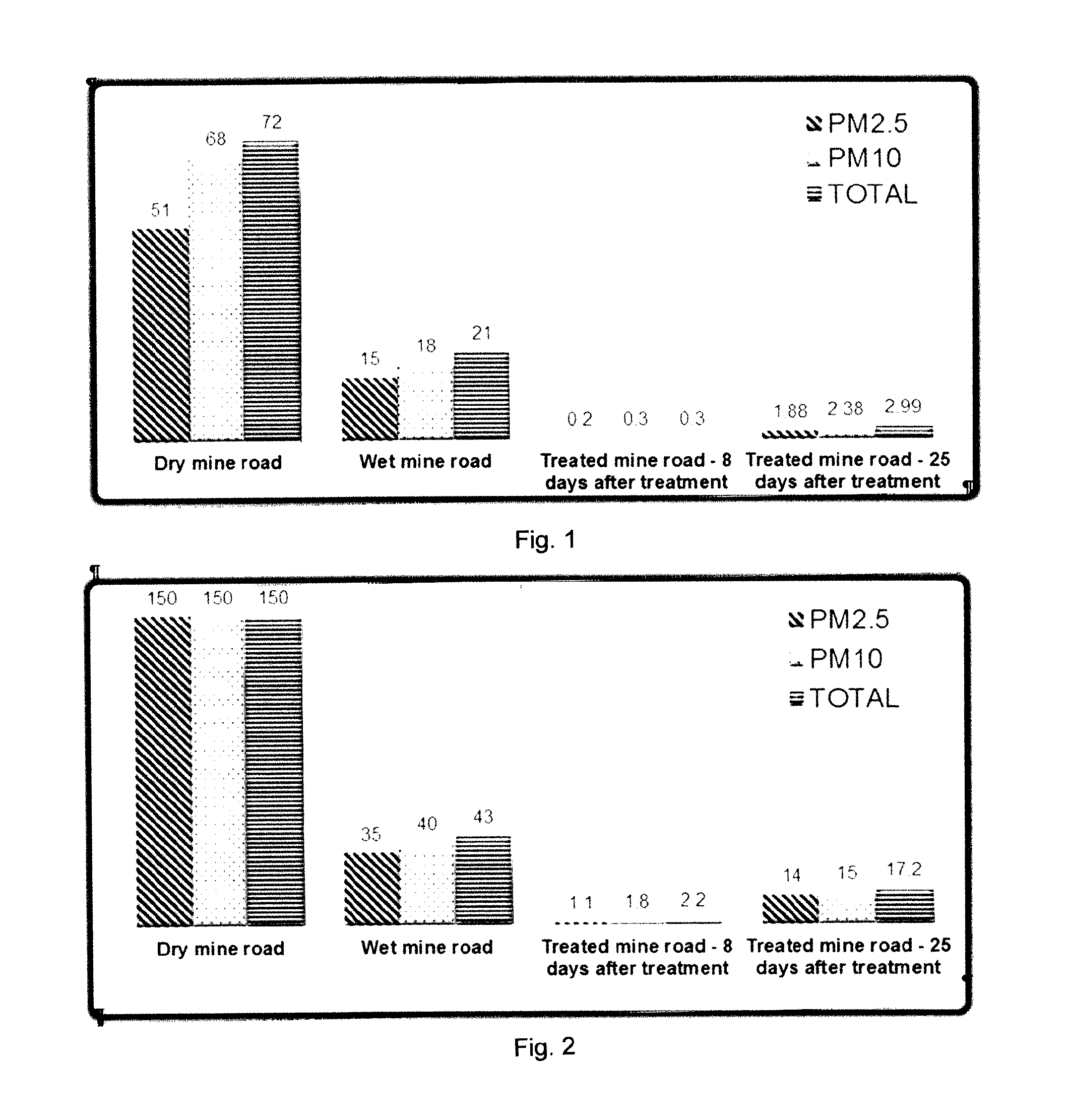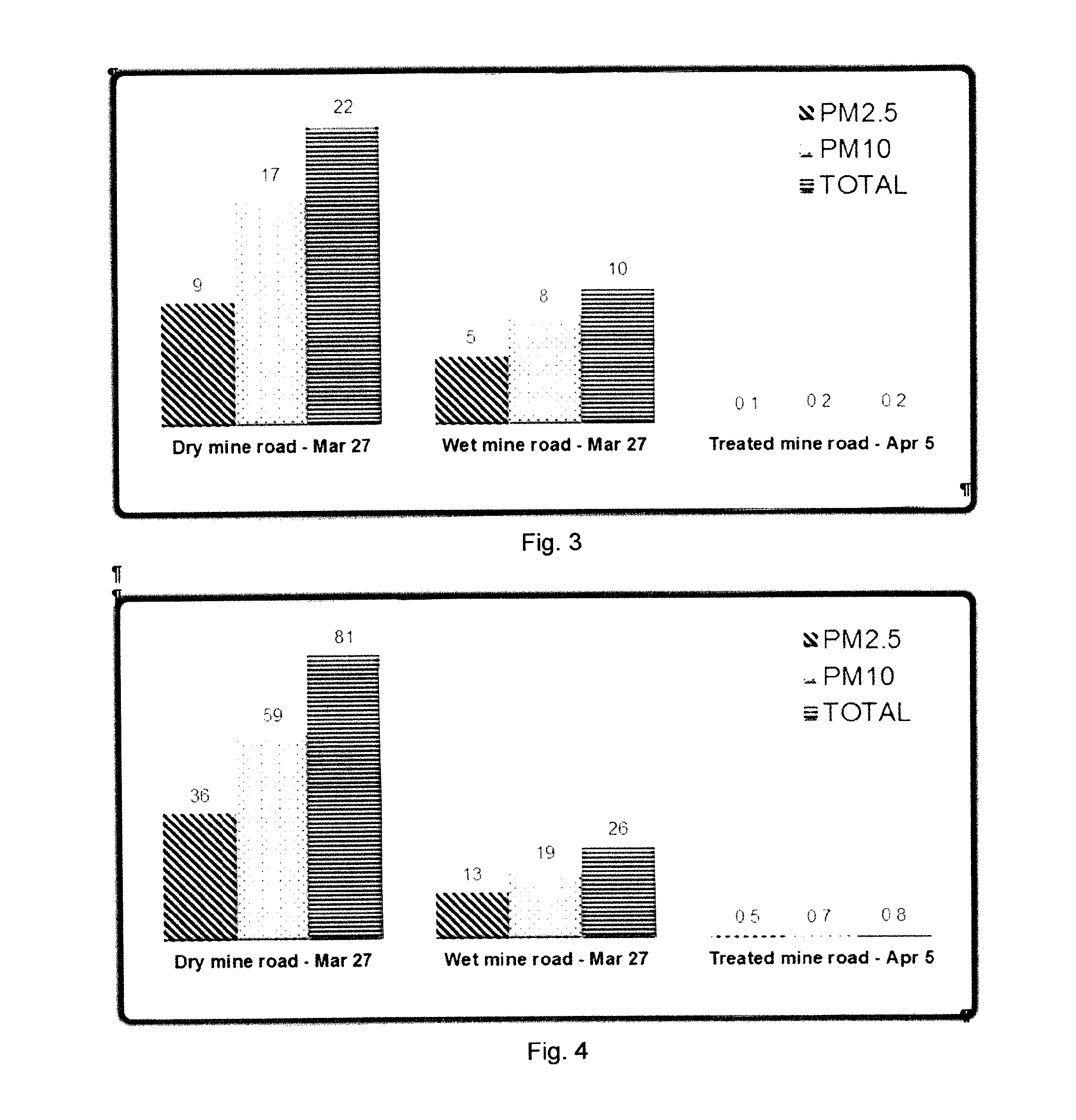Dust suppressant
- Summary
- Abstract
- Description
- Claims
- Application Information
AI Technical Summary
Benefits of technology
Problems solved by technology
Method used
Image
Examples
example 1
[0157]The composition was applied to the road using a spray bar and a pump. In the conditions tested, the application was made at a rate of between 5,000 to 10,000 gallons per km of road surface (although this can vary depending on road bed composition). The application was made to thoroughly cover the road. Generally, three to four applications per year would suffice to fully suppress the dust.
[0158]A dust suppressant formula was mixed according to the following formulation:
Amount by weightTechnical grade glycerine46% Lignosulfonate polymer2%Dust suppressing microbes2%Waterup to 100%
[0159]The dust suppressing microbes were a mixture of spores of Bacillus subtilis, Bacillus licheniformis, Bacillus amyloliquefaciens, and Bacillus megaterium. The final total spore concentration was approx. 3×107 CFU / mL.
[0160]The objective of the field test performed from Mar. 26, 2012 to Apr. 22, 2012 was to evaluate the ability and effectiveness of the dust suppressant to control dust em...
example 2
Field Trial II
[0177]Another field trial was carried out at the African continent, essentially as described in Example 1, with the exemption of polymer in the carrier, and an optimized treatment protocol for the variation in road bed. In this field trial the road bed had a larger clay content than in Example 1. The dust suppressant formulation was tested at a 3,750 m2 area, and the driving speeds for both monitoring measurements were increased to 50 km / h.
[0178]The PMTotal was reduced to <0.4 ppm, corresponding to a reduction of PM of 88% and 63% respectively for the dry zone and the wet zone. The dry zone was an area of the road where nothing had been applied during the testing period, whereas the wet zone was an area sprayed with water twice a day during the testing period.
example 3
Spore Formulation
[0179]The experiment was conducted to demonstrate the dust suppressing effect of bacterial spores delivered to soil in a liquid carrier.
Materials
[0180]Sieved Slotsgrus® (Stenrand Grusgrav, Denmark), particle size ≦1 mm (autoclaved and dried); 0.45 μm Minisart® HighFlow syringe filter with Polyethersulfone (PES) membrane filter—28 mm filter, order no. 16537.
Carrier Formulation
[0181]40% Glycerol[0182]1% lignosulfonic acid sodium salt[0183]Mineral salts (g / L)
[0184]2.0 NaNO3
[0185]0.1 KCl
[0186]0.5 KH2PO4
[0187]1.0 K2HPO4
[0188]0.01 CaCl2
[0189]0.5 MgSO4, 7H2O[0190]Trace metals (mg / L)
[0191]2.75 CaCl2, 2H2O
[0192]6.75 FeCl3, 6H2O
[0193]0.50 MnCl2, 4H2O
[0194]0.85 ZnCl2
[0195]0.22 CuSO4, 5H2O
[0196]0.55 CoCl2, 6H2O
[0197]0.30 (NH4)6Mo7O24, 4H2O
[0198]0.34 Na2B4O7, 10H2O[0199]Milli-Q water
Bacterial Spores
[0200]Bacillus subtilis [0201]Bacillus licheniformis [0202]Bacillus amyloliquefaciens [0203]Bacillus megaterium [0204]The final total inoculum concentration was approx. 7×107 CFU...
PUM
 Login to View More
Login to View More Abstract
Description
Claims
Application Information
 Login to View More
Login to View More - R&D
- Intellectual Property
- Life Sciences
- Materials
- Tech Scout
- Unparalleled Data Quality
- Higher Quality Content
- 60% Fewer Hallucinations
Browse by: Latest US Patents, China's latest patents, Technical Efficacy Thesaurus, Application Domain, Technology Topic, Popular Technical Reports.
© 2025 PatSnap. All rights reserved.Legal|Privacy policy|Modern Slavery Act Transparency Statement|Sitemap|About US| Contact US: help@patsnap.com


